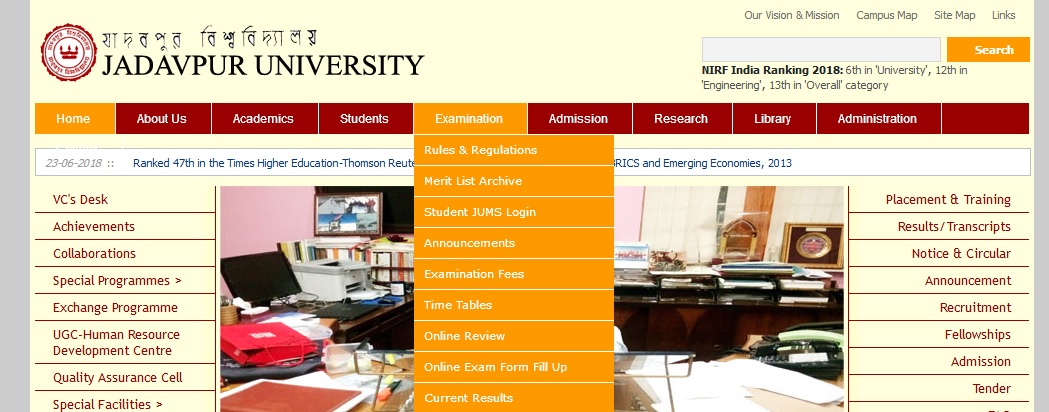Mechanical Metallurgy B.E Question Paper : jaduniv.edu.in
Name of the University : Jadavpur University
Department : Metallurgical Engineering
Degree : B.E
Subject Name : Mechanical Metallurgy
Sem : I
Website : jaduniv.edu.in
Document Type : Model Question Paper
Download Model/Sample Question Paper : https://www.pdfquestion.in/uploads/dspace.jdvu.ac.in/5470-MECHANICAL%20METALLURGY_Seme1_Part1_2006.pdf
Jadavpur Mechanical Metallurgy Question Paper
B.Met.E, Part -1, First Semester Examination, 2006 :
Subject: Mechanical Metallurgy
Time: Three Hours
Related : Jadavpur University Materials Science B.E Question Paper : www.pdfquestion.in/5469.html
Full Marks: 100
(Answer Question No. 1 and any four from the rest)
Sample Questions
Q 1. Answer any five from the following: (20)
(a) Brittle fracture is more prevalent at low temperature – Explain
(b) Grey cast iron is brittle but nodular cast iron is ductile – Explain
(c) Lomer Cottrell Barriers are not formed in metals having HCP crystal structure – Justify whether True or False.
(d) Annealing twins are not observed in aluminium, but in copper.
(e) Calculate the spacing between dislocations in a tilt boundary in FCC copper, when the angle of tilt is 2°.
(f) What are the differences between “slip” and “twinning”?.
Q 2. (a) By drawing a neat diagram showing the plane and direction discuss the formation of Lomer- Cottrell barrier and its consequence on the plastic deformation process. (10)
(b) Discuss the Strain Ageing phenomena. What is dynamic strain ageing? 7+3=10
Q 3. (a) What is the difference between Precipitation Hardening and Dispersion Hardening? By giving a suitable example elucidate the mechanisms for precipitation strengthening. Enumerate in detail the underlying deformation mechanisms for underaged, peak aged and overaged conditions of the alloy system 4+4+8=16

(b) In a simple cubic crystal (a = 3 Angstrom), a positive edge dislocation 1 mm long climbs down by 1 micron. How many vacancies are lost or created in such movement? 4
Q 4. (a) The yield strength of polycrystalline material increases from 120 MPa to 220 MPa, on decreasing the grain diameter from 0.04 to 0.01 mm. Find the yield stress for a grain size of ASTM 9. (4)
(b) What crystallographic factors usually determine the planes and directions on which slip occurs? How does one of these factors determine the temperature sensitivity of the yield strength? (6)
(c) After deriving the relationships for the stress field around a screw dislocation the relationship for the strain energy when the dislocation is of length 1. (10)
Q 5. (a) Give an account for the dislocation theory for Brittle fracture. (12)
(c) What is meant by Planar Slip and Wavy Slip? Considering single phase system explain the role of slip character in the plastic deformation process. (8)
Q 6. (a) Derive the Hall-Petch Equation on the basis of Dislocation Theory (8)
(b) With neat diagram discuss the underlying mechanism for cross slip of extended dislocations. (12)
Q 7. (a) By deriving the necessary relationship find the correlation between Grififth’s fracture stress and that obtained from stress concentration view point in case of an infinitely wide plate with an elliptical crack. (14)
(b) Discuss the effect of yield strength on the specimen thickness requirement for determining valid plane strain fracture toughness. (6)
Syllabus
Mechanical Metallurgy :
Elastic and plastic deformation of single crystals and polycrystalline aggregates. Cold working, recover, recrystallisation and grain growth. Annealing, orange peel effect; stretcher strain, yield point phenomenon. Aging quench aging, strain aging, strain age hardening.
Dislocations & dislocation mechanisms. Strengthening of metals and alloys. Deformation of metals and alloys. Fracture behaviour of metallic materials, fracture toughness etc. Ductile and brittle fracture.
Physical Metallurgy-II :
Fe-C system, steel and iron microstructures with phase relations, Free energy-composition diagrams. Ideal and non-ideal behaviour of alloy systems.
Diffusion : Diffusion laws, Kirkendall effect, activation energy etc. Transformation in metals and alloys – solidification and solid-state transformation. Nucleation and growth reactions: Homogeneous & Heterogeneous nucleation.
Dendritic solidification : Divorced eutectic, Super cooling, Interface calculation etc. Kinetics of solid-state transformation, C-curve etc. Segregation precipitation reaction. Phase Transformation processes
Diffusional phase transformation process : Short range difusional and long range diffusional process like polymorphic transformation, massive transformation, recrystallisation, precipitation transformation, order disorder, eutectoid and spinoidal transformations.